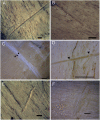Configurational approach to identifying the earliest hominin butchers
- PMID: 21078985
- PMCID: PMC3000273
- DOI: 10.1073/pnas.1013711107
Configurational approach to identifying the earliest hominin butchers
Abstract
The announcement of two approximately 3.4-million-y-old purportedly butchered fossil bones from the Dikika paleoanthropological research area (Lower Awash Valley, Ethiopia) could profoundly alter our understanding of human evolution. Butchering damage on the Dikika bones would imply that tool-assisted meat-eating began approximately 800,000 y before previously thought, based on butchered bones from 2.6- to 2.5-million-y-old sites at the Ethiopian Gona and Bouri localities. Further, the only hominin currently known from Dikika at approximately 3.4 Ma is Australopithecus afarensis, a temporally and geographically widespread species unassociated previously with any archaeological evidence of butchering. Our taphonomic configurational approach to assess the claims of A. afarensis butchery at Dikika suggests the claims of unexpectedly early butchering at the site are not warranted. The Dikika research group focused its analysis on the morphology of the marks in question but failed to demonstrate, through recovery of similarly marked in situ fossils, the exact provenience of the published fossils, and failed to note occurrences of random striae on the cortices of the published fossils (incurred through incidental movement of the defleshed specimens across and/or within their abrasive encasing sediments). The occurrence of such random striae (sometimes called collectively "trampling" damage) on the two fossils provide the configurational context for rejection of the claimed butchery marks. The earliest best evidence for hominin butchery thus remains at 2.6 to 2.5 Ma, presumably associated with more derived species than A. afarensis.
Conflict of interest statement
The authors declare no conflict of interest.
Figures




Comment in
-
Tool-marked bones from before the Oldowan change the paradigm.Proc Natl Acad Sci U S A. 2011 May 24;108(21):E116; author reply E117. doi: 10.1073/pnas.1101298108. Epub 2011 May 2. Proc Natl Acad Sci U S A. 2011. PMID: 21536920 Free PMC article. No abstract available.
Similar articles
-
Taphonomy of fossils from the hominin-bearing deposits at Dikika, Ethiopia.J Hum Evol. 2015 Sep;86:112-35. doi: 10.1016/j.jhevol.2015.06.013. Epub 2015 Aug 13. J Hum Evol. 2015. PMID: 26277305
-
Evidence for stone-tool-assisted consumption of animal tissues before 3.39 million years ago at Dikika, Ethiopia.Nature. 2010 Aug 12;466(7308):857-60. doi: 10.1038/nature09248. Nature. 2010. PMID: 20703305
-
Geological and palaeontological context of a Pliocene juvenile hominin at Dikika, Ethiopia.Nature. 2006 Sep 21;443(7109):332-6. doi: 10.1038/nature05048. Nature. 2006. PMID: 16988711
-
Interpreting the posture and locomotion of Australopithecus afarensis: where do we stand?Am J Phys Anthropol. 2002;Suppl 35:185-215. doi: 10.1002/ajpa.10185. Am J Phys Anthropol. 2002. PMID: 12653313 Review.
-
Flaked stones and old bones: biological and cultural evolution at the dawn of technology.Am J Phys Anthropol. 2004;Suppl 39:118-64. doi: 10.1002/ajpa.20157. Am J Phys Anthropol. 2004. PMID: 15605391 Review.
Cited by
-
Investigating the signature of aquatic resource use within Pleistocene hominin dietary adaptations.PLoS One. 2013 Aug 21;8(8):e69899. doi: 10.1371/journal.pone.0069899. eCollection 2013. PLoS One. 2013. PMID: 23990891 Free PMC article.
-
Morphological characteristics of preparator air-scribe marks: Implications for taphonomic research.PLoS One. 2018 Dec 20;13(12):e0209330. doi: 10.1371/journal.pone.0209330. eCollection 2018. PLoS One. 2018. PMID: 30571785 Free PMC article.
-
A way to break bones? The weight of intuitiveness.PLoS One. 2021 Oct 29;16(10):e0259136. doi: 10.1371/journal.pone.0259136. eCollection 2021. PLoS One. 2021. PMID: 34714863 Free PMC article.
-
THE EXPOSOME IN HUMAN EVOLUTION: FROM DUST TO DIESEL.Q Rev Biol. 2019 Dec;94(4):333-394. doi: 10.1086/706768. Q Rev Biol. 2019. PMID: 32269391 Free PMC article.
-
Hominin presence in Eurasia by at least 1.95 million years ago.Nat Commun. 2025 Jan 20;16(1):836. doi: 10.1038/s41467-025-56154-9. Nat Commun. 2025. PMID: 39833162 Free PMC article.
References
-
- McPherron SP, et al. Evidence for stone-tool-assisted consumption of animal tissues before 3.39 million years ago at Dikika, Ethiopia. Nature. 2010;466:857–860. - PubMed
-
- de Heinzelin J, et al. Environment and behavior of 2.5-million-year-old Bouri hominids. Science. 1999;284:625–629. - PubMed
-
- Semaw S, et al. 2.6-Million-year-old stone tools and associated bones from OGS-6 and OGS-7, Gona, Afar, Ethiopia. J Hum Evol. 2003;45:169–177. - PubMed
-
- Domínguez-Rodrigo M, Pickering TR, Semaw S, Rogers MJ. Cutmarked bones from Pliocene archaeological sites at Gona, Afar, Ethiopia: implications for the function of the world's oldest stone tools. J Hum Evol. 2005;48:109–121. - PubMed
-
- Alemseged Z, et al. A juvenile early hominin skeleton from Dikika, Ethiopia. Nature. 2006;443:296–301. - PubMed
Publication types
MeSH terms
LinkOut - more resources
Full Text Sources

